
- Source: BMORE ART
- Author: JOSEPH SHAIKEWITZ
- Date: APRIL 19, 2017
- Format: DIGITAL
ALSO QUEER AT THE 2017 WHITNEY BIENNIAL
Queer Artists and Voices at the 2017 Whitney Biennial by Joseph Shaikewitz
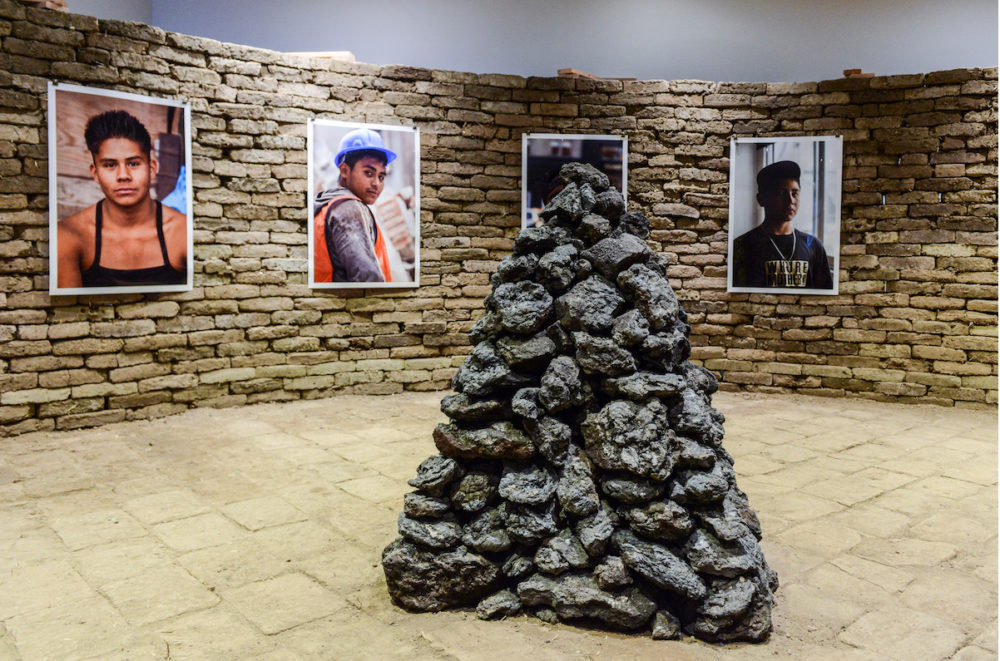
“I got a call from a Whitney Biennial curator,” a young Lyle Ashton Harris shares in confidence to an unseen caller. Comfortably laid out across a mattress in his bedroom, Harris speaks into a cordless phone and an adjacent microphone while a fixed video camera records his private dialogue. It was unlikely that the artist, in his 20s at the time the footage was captured, foresaw his ultimate inclusion some thirty years later in the 2017 Whitney Biennial.
Already, this year’s Biennial is being lauded as one of the more—if not most—inclusive presentations of the Whitney’s cornerstone exhibition, specifically with relation to the racial and gender diversity of its artists. Though there are contested inclusions, taken as a whole the presentation seeks greater representation where its predecessors have oftentimes fallen flat. The result is a thematically porous exhibition that speaks to, augments, and lays bare our current American moment.
In striving towards this more self-aware racial and gender equity (by some counts half of the exhibition’s 63 artists are non-white and nearly one half are female), there remains an oft understudied gloss of the Biennial’s treatment of queer identity. The smattering of artists outwardly addressing themes of gender and sexual inassimilation offer a perhaps inadvertent yet urgent-as-ever subtext throughout the Whitney’s galleries. A more inclusive biennial consequently makes room for greater complexity and nuance in its readings of contemporary queer politics, a subject that has historically skewed toward legacies of suffering, reductive binaries of liberation vs. oppression, and flippant stereotyping—lest it be overlooked altogether.
In the 2017 Biennial, the idea of non-normative sexual and gender identities emerges through a more truthful array of lenses, surfacing visual approaches that limn questions of autobiography alongside economics and politics. Where the curators’ choice of artists ensures a space for more singular voices, so too does it invite a secondary reading of contemporary experiences of queerness that collectively complicate and modernize a historically fraught approach.
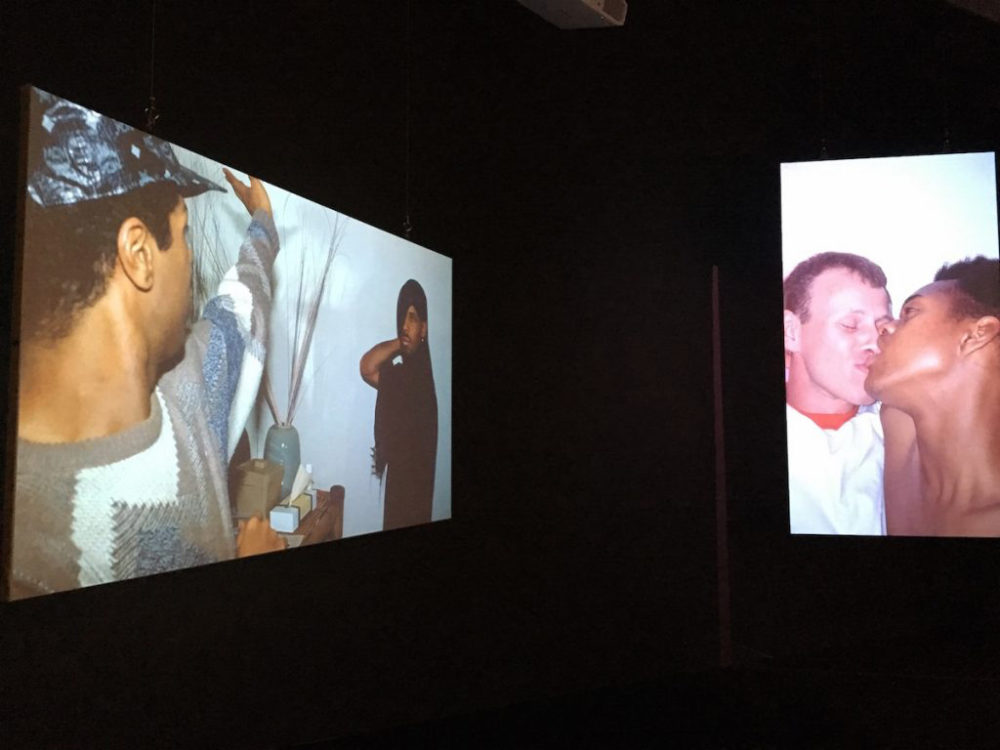
Lyle Ashton Harris, Ektachrome Archives (New York Mix), 2016
Take, for example, Harris’s installation Once (Now) Again (2017), which includes the abovementioned video Untitled (for Tommy) (2016). Though perhaps the most commonplace example in its body and identity-driven approach to queer politics, the artist proposes a fresh recognition of queer individuals’ preservation of public and private selves. In order to access Harris’ intimate phone calls and dialogue in Untitled (for Tommy), one must first pass through a series of discrete layers—a viewing experience presupposed on an encounter of three other photography- and film-based works that share the space.
The gallery opens on Ektachrome Archives (New York Mix) (2016). Three screens float around the gallery’s entrance and bear a projected slideshow of stills taken by the artist between 1986 and 1996. Grace Jones’ cover of ‘Walking in the Rain’ from her 1981 album Nightclubbing plays overhead, simulating the imagined overture to (or perhaps nostalgic replaying of) an unruly night out. Harris’ photographs flash across the hovering screens, seductive in their crisp colors and revelatory glimpses into the artist’s daily life. Portraits of friends and lovers, views of club life and gallery crowds, and records of sex, art, and triumph create a capsule of queer American life only a few decades ago.
Continuing through the black box space, the viewer crosses four silk panels that effectively divide the room in two. This fabric partition hosts Untitled (Beachwood Canyon, circa mid 1990s) (2016), a silent video projection of what appear to be tree branches and a layer of water droplets tinted a deep red hue. These forms flirt with textural abstraction, the fluttering screen and its image curiously approximating an oversized graft of human tissue. The curtain becomes at once physical and psychological, separating not only the gallery, but also Harris’ public life (as seen in Ektachrome Archives) and his innermost thoughts that soon follow.
Upon passage beside the fabric divide, two final videos come into view: Untitled (Blue Snow) (2016)—a four-minute projection of snowfall as seen through a window—and the curious standout Untitled (for Tommy). As only briefly described above, the work features a continuous 38-minute clip of Harris speaking on the phone to a series of off-screen interlocutors. Arriving at this final work, one has the feeling of having passed into a deeply vulnerable, yet all the while familiar realm. The film’s narrative is at once linear and strangely atemporal—leisurely in its duration. The artist picks at his toes, plays with his hair, and pulls at the fleece blanket beneath him. Recording himself in this intimate setting, Harris goes into autobiographical autopilot as he discusses (and oftentimes repeats to different callers) dancing until 2AM the night prior, a possible stint back in his hometown of New York, and his recent separation from his ex-boyfriend (Tommy, the video’s namesake).
A smaller screen below the work completes the diptych, looping footage shot in Harris’ bathroom presumably from around the same time as its pair. The video shows a pink curtain closed before an occupied shower stall. For minutes, the piece produces no action—only an ambient soundtrack of running water. Finally Harris emerges from the shower, towels off, applies lotion to his skin, inspects himself in the mirror, and then leaves, prompting the video to repeat anew.
Through filmic access to these two private spaces in Harris’ home, the artist grants viewers entry to a series of contemplative and intimate moments that oscillate between candidness and performance. Untitled (for Tommy) is reminiscent of other self-portrait-like video work from artists of an earlier decade including Bruce Nauman and Joan Jonas and seems to fit within a genealogy of portrayals of private domestic spaces, from Carrie Mae Weems through to Latoya Ruby Frazier and Deana Lawson. However, the piece here and specifically its placement within a broader installation suggest the at times requisite formation of an inner and an outer self—the former only spatially accessible via the latter.
While a piece like Ektachrome Archives offers a carefree and haphazard presentation of Harris’ most visible and quotidian worldview, Untitled (for Tommy) plays with the unseen, rehearsed nature of identity, particularly in the hands of marginalized individuals. To be out and to be oneself, Harris seems to suggest, one balances the desire for authenticity with the lasting echoes of closeted suppression. “I feel like I’ve done a lot of hiding. I feel like I’ve hidden myself a lot,” he recounts at one point in the film, capturing an almost unresolved desire to reconcile these two parts of himself. The immersive installation, in turn, allows us to live that very reality.
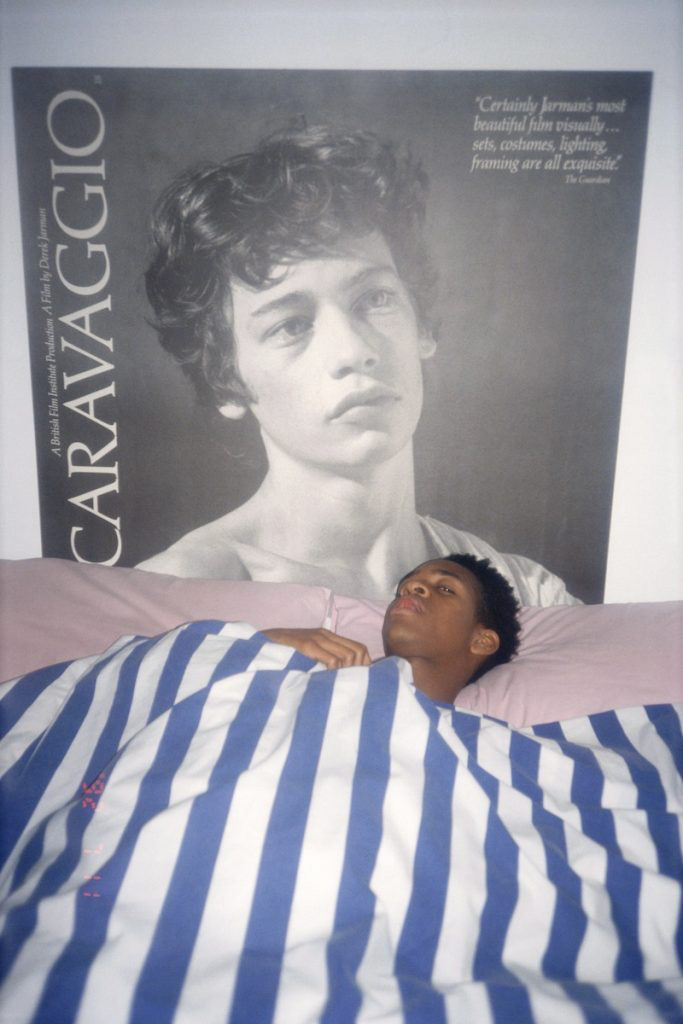
Lyle Ashton Harris, Lyle, London, 1992, 2015. Chromogenic print, 20 ½ x 15 in. (52.1 x 38.1 cm). Collection of the artist; courtesy the artist
Elsewhere in the Biennial, a handful of younger artists take on the task of depicting queerness through non-figurative means—a challenge for a theme that, traditionally, has pivoted on the presence and treatment of a human body. To briefly invoke sculptor and 2004 Biennial artist Tom Burr, who spoke to this idea in his own practice in an interview late last year:
“At certain historical moments the invisibility of specific subjectivities and desires produces the impulse to “picture” or “show” those disappeared positions, most easily represented, maybe, by images of bodies themselves. I understand that this can be an extremely important project. But, in its simplicity, it risks eclipsing a more complex set of conditions, a context. […] During the late ’80s and early ’90s, if you wanted to talk about gay subjectivity and sexual identity, it tended to be through photography and imagery. It was a kind of shorthand for these political ideas. I believe that’s why the kind of fragmented, collage-based work I embarked on always seemed to get me where I wanted to go much more effectively. Because there was never just one image, and the images were always in relation to form, it allowed for a dialectic to emerge.”
This pursuit of a non-figural queerness and the exploration of its conditions appears central to the inquiry of 2017 Biennial artists Rafa Esparza, Torey Thornton, and Ulrike Müller. As they pursue strains of phenomenology seldom provoked in histories of queer art, they open the potential for expansive and multiplicitous modes of expression.
Upon his invitation to install in the Whitney’s first floor gallery space, Rafa Esparza invited five fellow artists working in sculpture, photography, and prose to the Biennial as well. In his immersive Figure Ground: Beyond the White Field (2017), the Los Angeles-based Esparza solicited volunteers to help construct a curving edifice made from handmade adobe bricks. These collaborative building projects, previously enacted at venues including the Hammer Museum and Los Angeles Contemporary Exhibitions, give rise to the polemics of Latino labor and this country’s reliance on immigrant bodies.
This most recent installation for the Biennial takes a turn through the specific solicitation of queer, Brown individuals (namely, Rooster Cabrera, Maria Garcia, and Zena Zendejas) to partake in the fabrication and assembly of the work. Participation by Esparza’s collaborators layers the project with heightened associations to capitalist production by queer bodies and tropes of heteronormativity and masculinity. Fingerprints lodged into the surface of assorted bricks make visible their sourced labor and trace the collective event that is the work’s construction. In turn, connotations of labor decay and arise anew, here as a means of building community and liberating one’s hands from the social boundaries that can accompany self-identification.
For me, the highlight of Esparza’s five invitees’ contributions to the installation is a sound piece by writer and poet Joe Jimenez. The work is only subtly present in the space, accessible through a small opening in the rotunda’s facade. A voice—presumably Jimenez’s—recites two of his texts: People Who Eat Pain and The Story of Tongue. I put my ear up to the wall and overhear The Story of Tongue, a rousing narrative on the internalized weight of inherited trauma. “I may not know the true extent to what my body can suffer; I’d like to believe it’s a knowledge my body deserves not to know.” Jimenez’ presence in the installation adds critical depth as he illustrates a diminishing chasm between the bodily and the metaphysical.
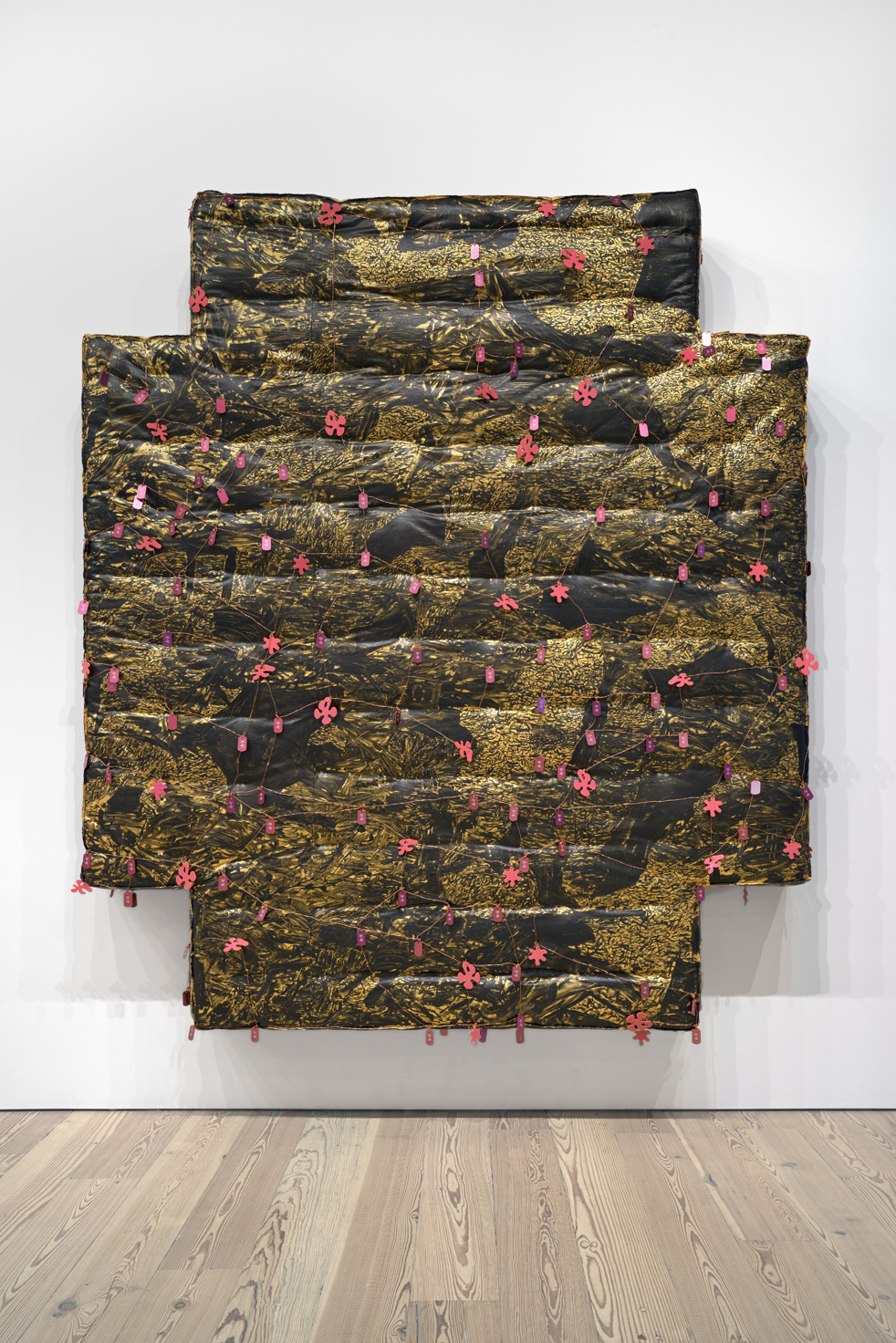
Torey Thornton, What Is Sexuality, Is The Scale Infinite Similar To a Line, 2017
Upstairs, two pieces by Torey Thornton operate within a visual language so personal and abstruse that interpretation totters on speculation (i.e. I’m really going to go out on a limb here). And yet, a compelling narrative emerges through his compilation of disparate found and forged materials. In the large-scale What Is Sexuality, Is The Scale Infinite Similar To A Line (2017), copper wire hugs the surface of an irregularly shaped mattress, which is painted in a camouflage palette with imagery reminiscent of a forestscape. Two types of pink forms are entangled in the barbed wire-esque web: aluminum military dog tags inscribed with the text “A-Z” and amorphous plexiglass splotches. These latter shapes are difficult to decipher; they read at once as coral designs or, as the title and use of a mattress might clue us in, cartoonish stains—artifacts of coital activity.
With such assumptions in place, one possible reading of this work positions it to comment on the shortcomings of certain strides toward LGBTQ equality. Its explicit militaristic motifs, titular reference to sexual orientation, and interwoven forms evoke the initial promise of the 2010 repeal of Don’t Ask, Don’t Tell (DADT), which allowed lesbian, gay, and bisexual servicemen and women to serve openly across all divisions of the armed forces. However, Thornton’s imagery of dog tags inciting a binary scale (“A-Z”) and floating pink splatters leads us to consider the messy implementation and unrealized protection of civil liberties that prevail in the wake of DADT’s revocation. It wasn’t until 2014 that the military decriminalized sodomy and, today in 2017, reforms are finally underway that, come July, will allow for the acceptance of openly transgender individuals. Meanwhile, ongoing discrimination, biases, and sexual assault run rampant, revealing the dispiriting aftermath of the policy’s repeal. Much as Thornton’s practice in general destabilizes meaning and the life cycle behind his materials, so too might What Is Sexuality draw viewers’ attention to an expanded temporality around attempts and actions towards LGBTQ equity.
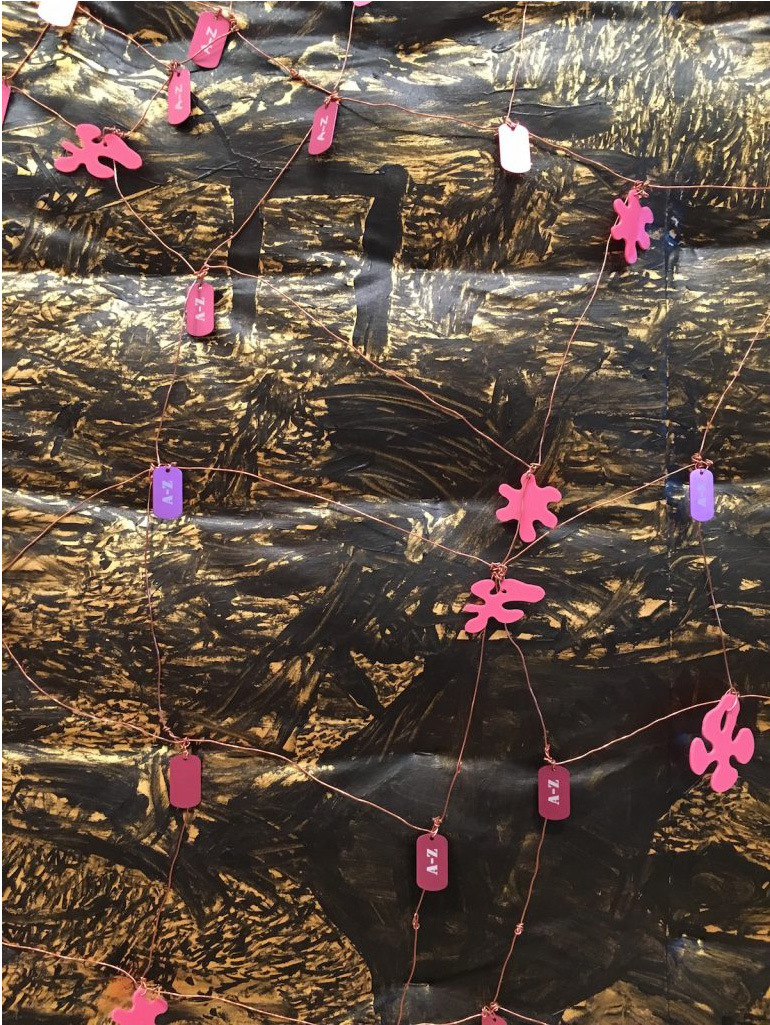
Torey Thornton, What Is Sexuality, Is The Scale Infinite Similar To a Line (detail), 2017
Ulrike Müller’s inclusion in the Biennial presented a moment to call attention to her recent work and that of the queergender artist collective LTTR that she’s been a member of since 2005. LTTR, an abbreviation of the original moniker ‘Lesbians to the Rescue’ from 2001, casts its feminist vision in the form of collaborations, performances, and an eponymous publication. Though most celebrated for her geometric paintings whose forms develop an almost cohabitational ethos, Müller’s indoor and outdoor installations at the Biennial offer less space for pointed contemplation.
With a collection of transitional spaces, Müller presents a grid of small-scale paintings on paper, a suite of enamel abstractions on steel, and one tapestry. In contrast to other works by the artist that I’ve encountered, the pieces chosen for the Biennial appear more tepid and muted in their formal construction and syntactic language. Her most recent enamel paintings on steel are rather redeeming, asserting their objecthood while robust in their patterning and design. Each jagged, sweeping, or bulbous form seems to call out to its neighbors, creating an experience of space that is at once pictorial and liminal in referencing the gallery itself.
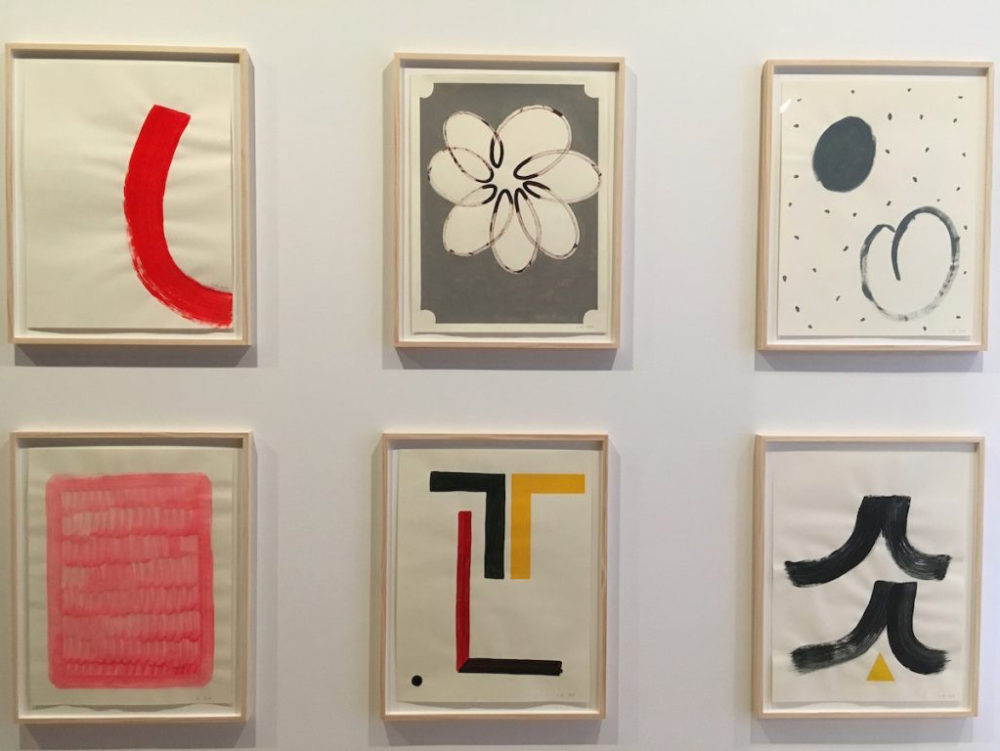
Installation view of Ulrike Müller, acrylic and chine-collé on paper, 2014
Across this small selection of artists overtly embracing themes of queerness in the Biennial, the viewer encounters a less confined, less narrow articulation of gender and sexual inassimilation, freeing such a topic from its most usual modes of curatorial presentation. Where Harris’ feature at the Whitney evokes an act of looking back—a portrait of a young, Black, and queer artist resurfaced and recontextualized—Esparza, Thornton, and Müller propose new methods of picturing queerness in conversation with an ever-expanding set of social undercurrents. However, Harris’ contribution should not be relegated to some retrospective position; quite the contrary, his work as an artist first developing in the 80s and 90s establishes him as an important predecessor, radically visualizing identity through his body at a particularly tense historical moment all the while continuing to advocate for such imagery today. In doing so, I would argue, he as well as his peers liberated artists over the past decade (including Esparza, Thornton, and Müller) to evolve a multivalent and perhaps more responsive context for queering their visual tactics.
The 2017 Whitney Biennial is one of the few group exhibitions where I’ve seen LGBTQ themes assume new languages to address their audiences with such fervor. And while I struggle to assert that the co-curators were fully deliberate in choosing such work, the result nevertheless sets the tone for a younger generation of queer artists who may encounter these approaches thanks to the Biennial’s international platform.
Nevertheless, there remains critical work to be done. To press the curators further, sadly all of the artists called upon above have their work presented in side galleries, peripheral spaces, or away from the grander narratives that snake throughout the exhibition.
In order to recognize these newer expressions of queerness, the artists would unquestionably benefit from more sustained conversation with the other works on view, thereby allowing them (as one might expect) to offer up their own distinct modes of visualizing today’s commonplace themes. Presentation in isolation only reinforces patterns of heteronormativity, whereas for the artists in question, queerness exists in active dialogue with broader social and cultural structures. For the Biennial to incorporate and even foreground these voices would be an important step in more wholly accessing their boundless and fertile potential.
I suppose there’s always 2019.

